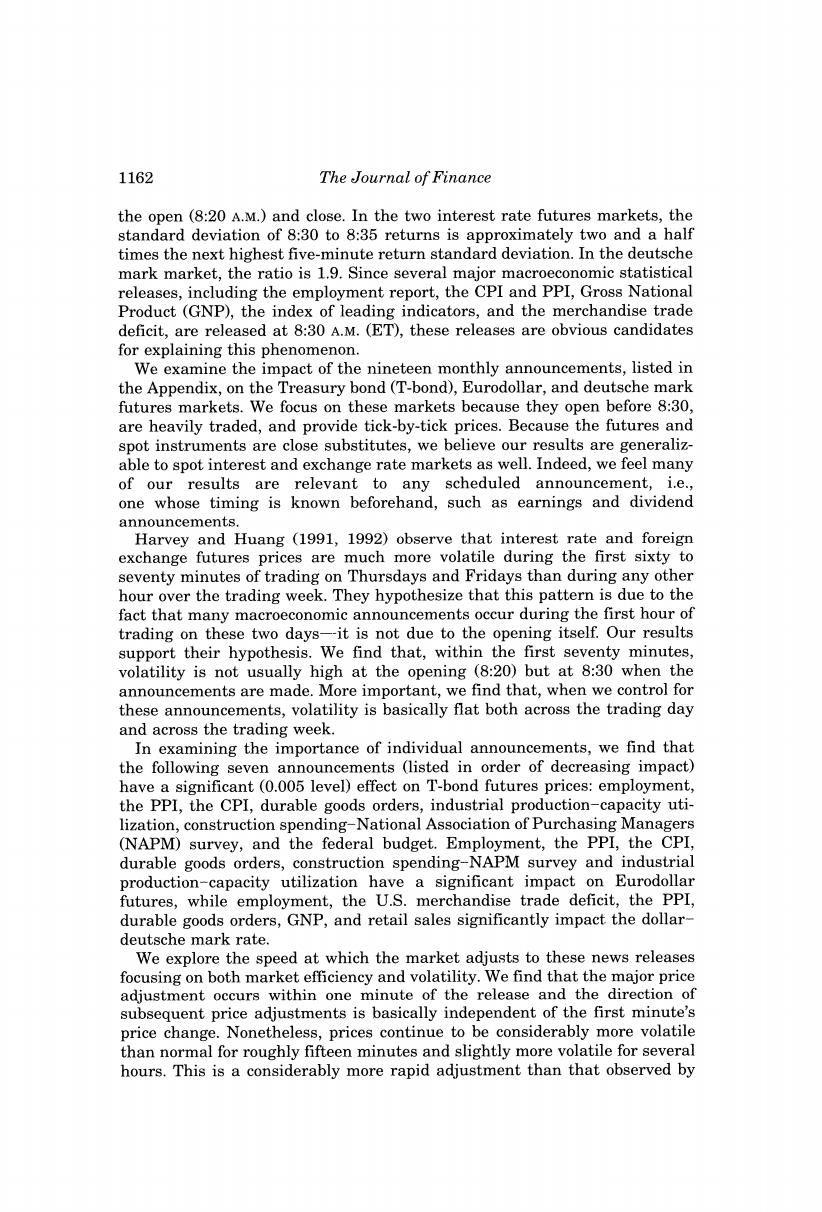正在加载图片...

1162 The Journal of Finance the open (8:20 A.M.)and close.In the two interest rate futures markets,the standard deviation of 8:30 to 8:35 returns is approximately two and a half times the next highest five-minute return standard deviation.In the deutsche mark market,the ratio is 1.9.Since several major macroeconomic statistical releases,including the employment report,the CPI and PPI,Gross National Product (GNP),the index of leading indicators,and the merchandise trade deficit,are released at 8:30 A.M.(ET),these releases are obvious candidates for explaining this phenomenon. We examine the impact of the nineteen monthly announcements,listed in the Appendix,on the Treasury bond(T-bond),Eurodollar,and deutsche mark futures markets.We focus on these markets because they open before 8:30, are heavily traded,and provide tick-by-tick prices.Because the futures and spot instruments are close substitutes,we believe our results are generaliz- able to spot interest and exchange rate markets as well.Indeed,we feel many of our results are relevant to any scheduled announcement,i.e., one whose timing is known beforehand,such as earnings and dividend announcements. Harvey and Huang (1991,1992)observe that interest rate and foreign exchange futures prices are much more volatile during the first sixty to seventy minutes of trading on Thursdays and Fridays than during any other hour over the trading week.They hypothesize that this pattern is due to the fact that many macroeconomic announcements occur during the first hour of trading on these two days-it is not due to the opening itself.Our results support their hypothesis.We find that,within the first seventy minutes, volatility is not usually high at the opening(8:20)but at 8:30 when the announcements are made.More important,we find that,when we control for these announcements,volatility is basically flat both across the trading day and across the trading week. In examining the importance of individual announcements,we find that the following seven announcements (listed in order of decreasing impact) have a significant(0.005 level)effect on T-bond futures prices:employment, the PPI,the CPI,durable goods orders,industrial production-capacity uti- lization,construction spending-National Association of Purchasing Managers (NAPM)survey,and the federal budget.Employment,the PPI,the CPI, durable goods orders,construction spending-NAPM survey and industrial production-capacity utilization have a significant impact on Eurodollar futures,while employment,the U.S.merchandise trade deficit,the PPI, durable goods orders,GNP,and retail sales significantly impact the dollar- deutsche mark rate. We explore the speed at which the market adjusts to these news releases focusing on both market efficiency and volatility.We find that the major price adjustment occurs within one minute of the release and the direction of subsequent price adjustments is basically independent of the first minute's price change.Nonetheless,prices continue to be considerably more volatile than normal for roughly fifteen minutes and slightly more volatile for several hours.This is a considerably more rapid adjustment than that observed by